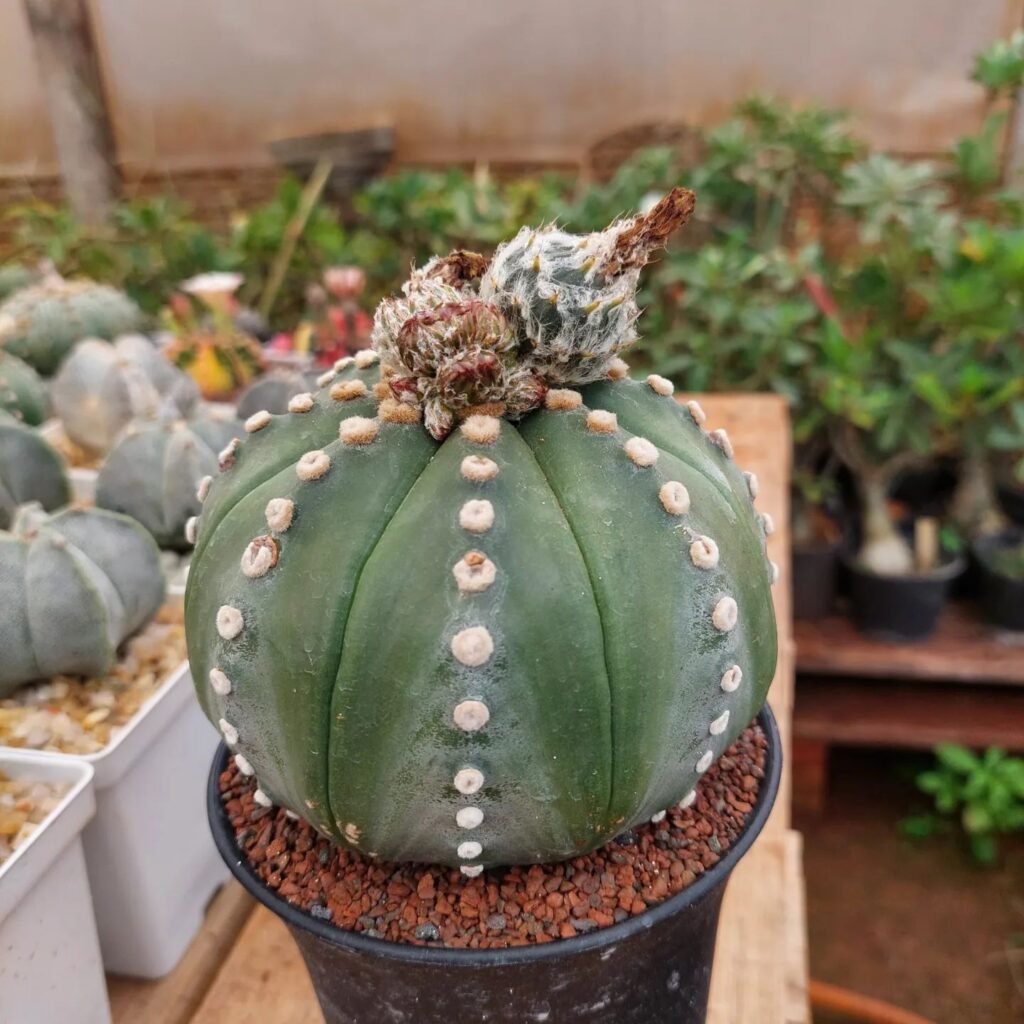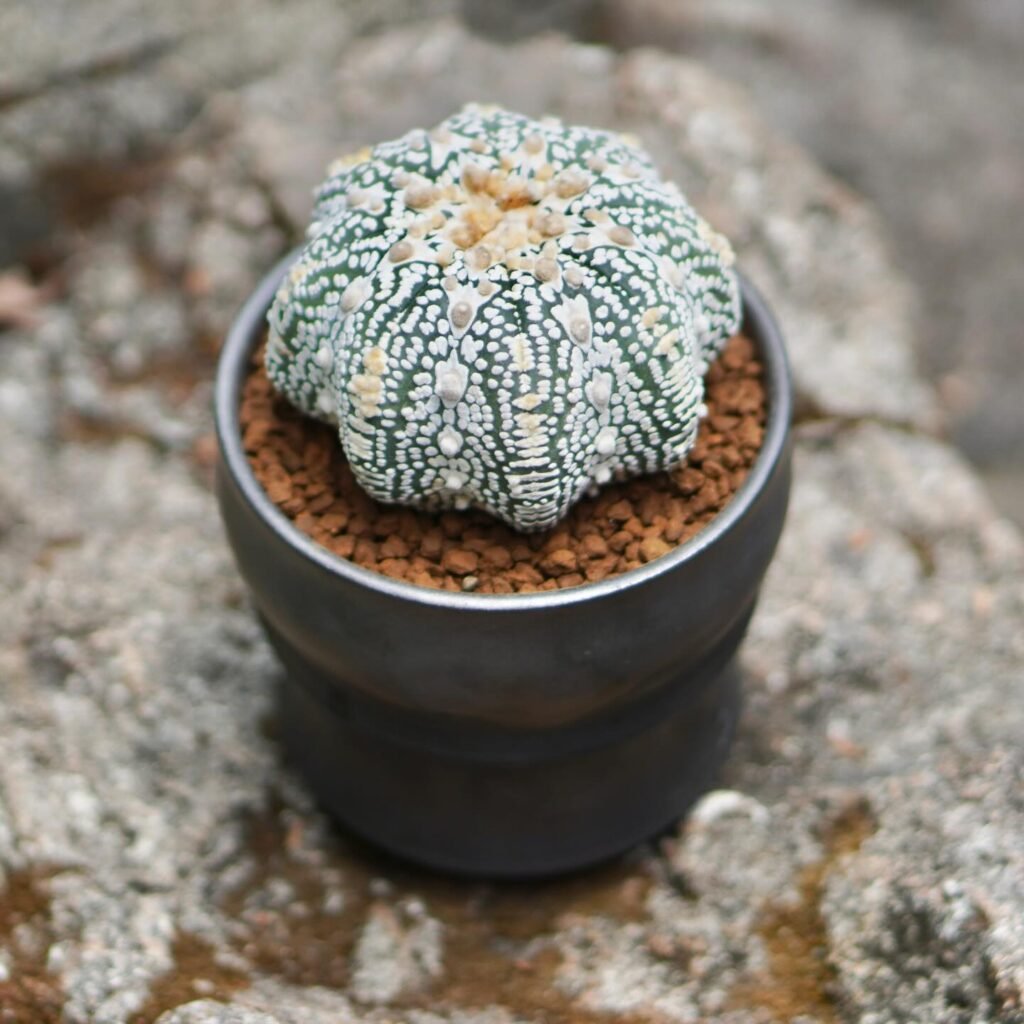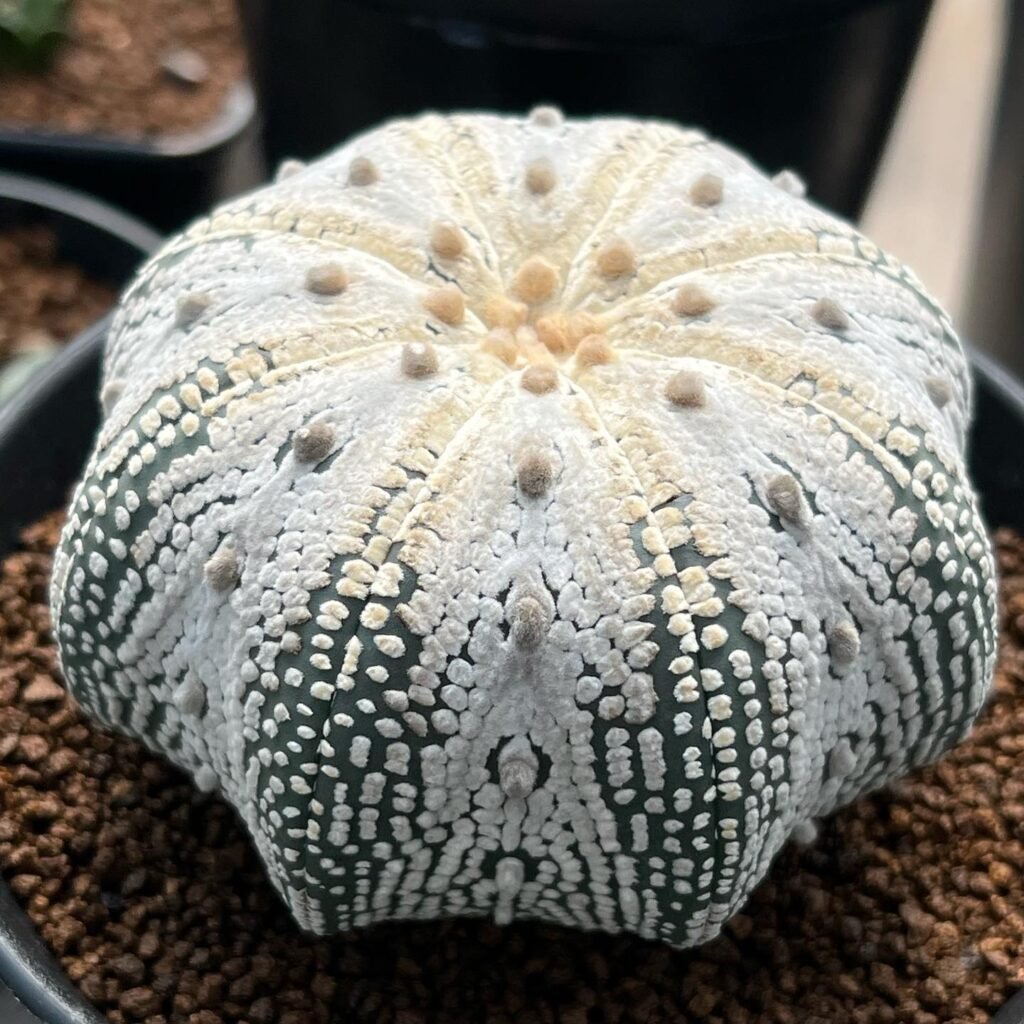Growing rare cacti like the Astrophytum asterias (Super Kabuto) can be a delightful challenge for succulent plant lovers. But have you ever wondered how to care for this unique cactus variety in the UK climate?
With its star-shaped markings and compact growth, the Super Kabuto is a true gem for indoor gardening enthusiasts and cactus lovers alike. In this article, I will share expert tips and essential advice on caring for Astrophytum asterias, the rare cactus that will transform your indoor garden. So, how can we ensure this rare beauty thrives in our British homes?
Appearance of Astrophytum asterias (Super Kabuto)


Astrophytum asterias, commonly referred to as Super Kabuto, stands out as an exceptional species of cactus hailing from regions such as Texas in the United States and parts of Mexico. Nestled within the Astrophytum genus, which encompasses a total of six distinct species, Super Kabuto is especially prized for its distinctive aesthetic attributes.
One of the most striking features of the Super Kabuto is its star-shaped markings adorning its body, which contribute to its unique and highly sought-after appearance. These markings are not just simple decorations; they imbue each cactus with a personality of its own, making them a favourite among cactus enthusiasts and collectors worldwide.
In terms of size, the Super Kabuto is rather modest, capable of reaching up to 10 cm in diameter. Despite its small stature, it commands attention with its robust, spherical to slightly flattened shape. This compact size makes it an ideal choice for those with limited space or who prefer a more manageable plant.
The surface of the Super Kabuto is smooth, featuring a green to blue-green hue that serves as a canvas for the white to yellowish star-shaped areoles. These areoles are not only decorative but functional, housing the spines that are characteristic of cacti. Interestingly, the Super Kabuto can vary significantly in the number and arrangement of these spines, adding to the uniqueness of each individual plant.
 The Super Kabuto is intriguingly named across cultures: its Japanese name reflects a samurai’s helmet, while its Greek-derived ‘Astrophytum’ highlights its star-like shape, combining notions of bravery and celestial beauty in one resilient plant.
The Super Kabuto is intriguingly named across cultures: its Japanese name reflects a samurai’s helmet, while its Greek-derived ‘Astrophytum’ highlights its star-like shape, combining notions of bravery and celestial beauty in one resilient plant.
Light Requirements for Astrophytum asterias (Super Kabuto)


Astrophytum asterias, also known as Super Kabuto, thrives when provided with an adequate amount of light. Whether you choose to grow it indoors or outdoors, it is essential to place it in a location that receives bright, indirect sunlight. However, direct sunlight should be avoided as it can lead to sunburn and damage the cactus’s delicate skin. Especially during the hottest hours of the day, it is important to provide some shade to protect your Astrophytum asterias.
A slanted or filtered light with an intensity of around 60-70% is ideally suited for the growth and well-being of your Astrophytum asterias. This ensures that the cactus receives the right amount of light without being overwhelmed by harsh, direct rays.
- Position your Astrophytum asterias in a location that receives bright, indirect sunlight.
- Avoid placing it in direct sunlight to prevent sunburn and damage.
- Provide some shading, especially during the hottest hours of the day.
- Slanted or filtered light with an intensity of 60-70% is ideal for Astrophytum asterias.

Watering Tips for Astrophytum asterias (Super Kabuto)


When it comes to watering Astrophytum asterias, less is definitely more. This drought-tolerant cactus should be watered sparingly to prevent overwatering and the associated risks of rot and fungal diseases. It’s crucial to allow the soil to dry out between waterings, providing the plant with the dry conditions it prefers.
During the growing season, it’s best to water Astrophytum asterias when the soil is completely dry. This ensures that the cactus receives the water it needs without risking excess moisture. However, during the rainy season or periods of high humidity, it’s important to exercise caution and avoid excessive watering. Overwatering can lead to root rot and other issues that can harm the plant’s overall health.
Remember, it’s always better to underwater than overwater Astrophytum asterias. This cactus is adapted to surviving in arid conditions, so it’s more tolerant of drought than excessive moisture. By practicing restraint with watering, you can help your Astrophytum asterias thrive and maintain its exquisite beauty.

Fertilizing and Soil for Astrophytum asterias (Super Kabuto)


When it comes to caring for your Astrophytum asterias, the right soil and fertilizing regimen are crucial for its well-being. This unique cactus thrives in well-draining soil that is low in organic matter. I recommend using a mineral-based substrate with good drainage to ensure the proper growth of your Super Kabuto.
During the growing season, your Astrophytum asterias can benefit from a low-nitrogen fertilizer to promote healthy growth. However, it’s important to exercise caution and avoid over-fertilizing, as this can result in excessive growth and elongation of the plant. I recommend using a balanced fertilizer formula with a lower nitrogen content to provide the necessary nutrients without encouraging excessive growth.
Remember, each cactus has its own unique needs, and it’s essential to find the right balance for your Astrophytum asterias. By using the appropriate soil and fertilizing in moderation, you can ensure that your Super Kabuto remains healthy and vibrant.
- Use a mineral-based substrate with good drainage for optimal growth.
- During the growing season, apply a low-nitrogen fertilizer to promote healthy growth.
- Avoid over-fertilizing to prevent excessive growth and elongation of the cactus.
- Opt for a balanced fertilizer formula with a lower nitrogen content.

Pruning and Maintenance of Astrophytum asterias (Super Kabuto)


When it comes to taking care of Astrophytum asterias, you’ll be glad to know that this unique houseplant is low-maintenance and requires minimal pruning.
Thanks to its compact growth habit, the Super Kabuto cactus doesn’t demand much intervention. However, it’s crucial to keep an eye out for any damaged or diseased parts of the plant.
If you spot any such areas, don’t hesitate to remove them promptly. Pruning the affected parts not only promotes new growth but also prevents the spread of diseases.
Regular inspection is key to maintaining the health of your Astrophytum asterias. Keep an eye out for signs of pests or diseases, and if you spot any, take appropriate action right away.

Propagating Astrophytum asterias (Super Kabuto)


If you’re eager to propagate your Astrophytum asterias (Super Kabuto) and expand your collection, there are a few methods you can try. The two most common methods for propagating Astrophytum asterias are seed propagation and grafting.
- Seed propagation: Collect seeds from mature Astrophytum asterias plants and sow them in well-draining soil. Make sure to provide the seeds with the right conditions, including adequate light and warmth, to encourage germination. Keep in mind that growing a healthy cactus from seeds can be a slow process, requiring patience and attention to detail.
- Grafting: Grafting involves attaching a cutting of the Astrophytum asterias to a different cactus rootstock. This method allows for accelerated growth and can be a great way to propagate your cactus. However, grafting requires specific skills and knowledge, so it’s recommended to seek guidance from experienced gardeners or horticulturists if you’re new to this technique.
Regardless of the method you choose, propagating Astrophytum asterias requires time and dedication. It’s important to provide the right growing conditions, such as well-draining soil and proper care, to ensure the success of your propagation efforts. With patience and attention to detail, you can expand your collection of Astrophytum asterias and enjoy the beauty of these unique cacti.

Repotting Tips for Astrophytum asterias (Super Kabuto)
Repotting is an essential aspect of caring for Astrophytum asterias to promote healthy growth. As the cactus matures, it will gradually outgrow its current pot and require a larger container to accommodate its expanding root system. To provide the best conditions for your Astrophytum asterias, follow these repotting tips:
- Repot every 2-3 years: It is recommended to repot your Astrophytum asterias every 2-3 years. This timeframe allows the cactus to establish itself in its current pot and ensures that it has ample space to grow and thrive.
- Select a well-draining substrate: When repotting, choose a well-draining substrate that mimics the cactus’s natural habitat. A mixture of cactus potting mix and perlite or pumice can provide the ideal balance of moisture retention and drainage.
- Handle with care: During the repotting process, it is crucial to handle your Astrophytum asterias with utmost care to avoid damaging its delicate root system. Gently lift the cactus from its current pot, supporting the base with one hand and carefully loosening the roots with the other.
- Refresh the soil: Repotting presents an excellent opportunity to refresh the soil and provide your Astrophytum asterias with fresh nutrients. Remove any old or compacted soil from the roots and replace it with the new substrate, ensuring that the cactus is secure and upright in its new pot.
 A cool fact about Astrophytum asterias, or Super Kabuto, is its surprise yellow blooms. Despite its rugged look, it produces rare, stunning flowers, turning each bloom into a celebrated event. It’s a desert marvel, showcasing beauty in unexpected forms.
A cool fact about Astrophytum asterias, or Super Kabuto, is its surprise yellow blooms. Despite its rugged look, it produces rare, stunning flowers, turning each bloom into a celebrated event. It’s a desert marvel, showcasing beauty in unexpected forms.
Helpful Videos about Astrophytum asterias (Super Kabuto)
I’ve stumbled upon some marvellous videos on nurturing Astrophytum asterias (Super Kabuto), which are bursting with tips to make caring for this plant straightforward. Perfect for those just beginning their gardening journey! Feel free to check them out.
- How to Take Care of a Star Cactus (Astrophytum Asterias)
FAQ about Astrophytum asterias (Super Kabuto)

Fascinated by the prospect of caring for your Astrophytum asterias (Super Kabuto)? You’ve stumbled upon the perfect guide! I’ve put together all the crucial queries to simplify the care for your Super Kabuto. Whether it’s nailing the perfect watering regime or tackling any peculiar leaf issues, I’m here to guide you through.
Astrophytum asterias, known as Super Kabuto, is a type of cactus that’s prized for its star-shaped appearance and interesting patterns on its surface. It’s native to parts of Mexico but can be grown in the UK with proper care.
Water your Super Kabuto sparingly. During the growing season (spring and summer), water it every 2-3 weeks, allowing the soil to dry out completely between waterings. In winter, reduce watering to once a month or less.
A well-draining cactus mix is ideal for Astrophytum asterias. Create your own mix with two parts sand or gravel, one part garden soil, and one part peat or compost for optimal drainage and root health.
Yes, but only lightly. Feed Astrophytum asterias with a diluted cactus fertilizer monthly during its growing season. Avoid fertilizing in winter.
Astrophytum asterias prefers bright, indirect sunlight. Position it by a south-facing window in the UK, but shield it from the intense midday sun in summer to prevent burns.
Yes, in pots for easy transition indoors during colder months. Astrophytum asterias can enjoy outdoor summer weather in the UK but must be protected from rain and brought indoors before autumn’s cooler temperatures.
Repot Astrophytum asterias in spring every few years or when it outgrows its container. Choose a slightly larger pot and handle the roots with care to prevent damage.
Yellowing could indicate overwatering or inadequate drainage. Make sure the soil is well-draining and allow it to fully dry between waterings.
Propagation of Astrophytum asterias is usually done through seeds. Plant the seeds in well-draining soil, keep moist, and wait patiently for germination, which may take several weeks to months.
Flowering depends on the plant’s age, care, and season. Ensure it receives adequate light and water. Patience is key as the plant matures and adjusts to its environment.
Regularly check for pests like mealybugs and treat with suitable insecticide or alcohol-dipped cotton swabs for removal.
Astrophytum asterias flourishes in temperatures between 18°C and 30°C. Protect it from temperatures below 10°C to prevent cold damage.
Astrophytum asterias prefers a dry climate. In humid conditions, increase air circulation to prevent fungal diseases.
Astrophytum asterias can grow up to 15 cm in diameter in cultivation, depending on age and care. Growth is slow, so patience is required.
The white dots or flecks are natural and part of what makes the Super Kabuto variety distinctive. They are not a sign of disease or pests but rather are unique to this cactus’s appearance.
I hope this FAQ has made looking after your Astrophytum asterias (Super Kabuto) a bit clearer. Missed something? No worries! Just drop your question in the comments, and I’ll get back to you. Remember, we all start from zero with plants, and there’s always new stuff to learn as they grow.
Conclusion
Caring for Astrophytum asterias (Super Kabuto) is a delightful experience for cactus and indoor gardening enthusiasts. This unique houseplant adds an elegant touch to any space and is incredibly low maintenance. By providing the proper light, watering sparingly, using well-draining soil, and repotting when necessary, you can ensure the healthy growth of this extraordinary plant. With its fascinating appearance and easy care requirements, Astrophytum asterias is truly a star among houseplants.
Astrophytum asterias care is centered around providing the right amount of sunlight. This cactus thrives in bright, indirect light, so placing it near a south-facing window or providing filtered light will help it flourish. Remember to protect it from direct sunlight, as this can cause damage to its delicate skin.
When it comes to watering, Astrophytum asterias is drought-tolerant and should be watered sparingly. Allow the soil to dry out completely between waterings to prevent overwatering and root rot. During the growing season, it’s best to water only when the soil is completely dry.
In terms of soil, this cactus prefers a well-draining substrate with minimal organic matter. A mineral-based soil mix specifically formulated for cacti and succulents is ideal for Astrophytum asterias. This will ensure proper drainage and prevent waterlogged roots.
Finally, repotting Astrophytum asterias every 2-3 years will provide it with fresh nutrients and allow for continued growth. When repotting, handle the cactus with care to avoid damaging its roots. Use this opportunity to provide a slightly larger pot and fresh soil.
With these care tips, you can enjoy the beauty of Astrophytum asterias without much effort. This unique houseplant is a stunning addition to any indoor garden and will thrive with minimal attention. Embrace the joy of nurturing this low maintenance plant, and let it bring an enchanting touch to your space.

